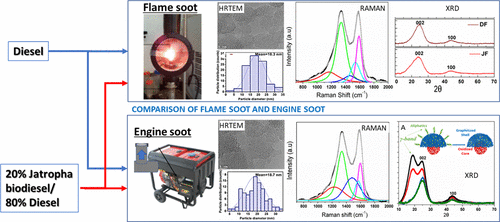当前位置:
X-MOL 学术
›
Energy Fuels
›
论文详情
Our official English website, www.x-mol.net, welcomes your feedback! (Note: you will need to create a separate account there.)
Nanostructural Disorder and Reactivity Comparison of Flame Soot and Engine Soot Using Diesel and Jatropha Biodiesel/Diesel Blend as Fuels
Energy & Fuels ( IF 5.3 ) Pub Date : 2020-09-23 , DOI: 10.1021/acs.energyfuels.0c02063 Pranay P. Morajkar 1, 2 , Moataz K. Abdrabou 1 , Akshay V. Salkar 2 , Abhijeet Raj 1, 3 , Mirella Elkadi 4 , Dalaver H. Anjum 3, 5
Energy & Fuels ( IF 5.3 ) Pub Date : 2020-09-23 , DOI: 10.1021/acs.energyfuels.0c02063 Pranay P. Morajkar 1, 2 , Moataz K. Abdrabou 1 , Akshay V. Salkar 2 , Abhijeet Raj 1, 3 , Mirella Elkadi 4 , Dalaver H. Anjum 3, 5
Affiliation

|
Soot is a major anthropogenic air pollutant that affects human health and contributes to global warming. To understand its formation pathways and reduce emission, several flame and engine studies exist in the literature, though the fundamental differences in the characteristics of engine and flame soots are not well understood. This study presents a detailed comparative investigation of soot nanostructural properties and their relationship with the oxidative reactivity of soots from an engine and a diffusion flame using diesel and 20% Jatropha biodiesel/diesel blend fuels. X-ray diffraction, Raman spectroscopy, high-resolution transmission electron microscopy, electron energy loss spectroscopy, and thermogravimetric analyses confirm that engine soot has greater primary particle diameter, higher concentration of loosely held aliphatics, greater degree of graphitized nanocrystallites with lower interplanar separation, longer fringe lengths, lower tortuosity, and greater resistance for oxidation than the flame soot, though the differences in several properties were minor. The effects of biodiesel addition to diesel on soot properties and sooting tendency were predicted very well with both flame and engine setup. Moreover, the enhanced soot oxidation in the combustor catalyzed by fuel-bound oxygen in biodiesel further reduces the nanostructural and reactivity differences between engine and flame soots. Though engine soot properties have more relevance to anthropogenic particulate matter, flame setups appear to be suitable for screening and studying the effect of fuel additives on the sooting propensity and physicochemical properties of soot prior to their testing and utilization in engines.
中文翻译:

柴油和麻风树生物柴油/柴油共混物作为燃料的火焰灰和发动机灰的纳米结构紊乱和反应性比较
烟灰是一种主要的人为空气污染物,会影响人类健康并导致全球变暖。为了理解其形成途径并减少排放,尽管对发动机和火焰烟灰特性的根本差异还不甚了解,但文献中已有一些关于火焰和发动机的研究。这项研究提供了使用柴油和20%麻风树生物柴油/柴油混合燃料对烟尘纳米结构特性及其与引擎烟尘和扩散火焰的氧化反应性之间关系的详细比较研究。X射线衍射,拉曼光谱,高分辨率透射电子显微镜,电子能量损失光谱和热重分析证实,发动机煤烟具有更大的初级粒径,较高浓度的疏松脂族,石墨化纳米晶体具有更高的石墨化度,其面间距更低,条纹长度更长,曲折性更低,并且抗氧化性比火焰烟灰更高,尽管在某些特性上的差异很小。在火焰和发动机设置下,都很好地预测了生物柴油添加到柴油中对烟灰性能和烟灰趋势的影响。此外,通过生物柴油中燃料结合的氧气催化的燃烧器中烟灰氧化的增强,进一步减小了发动机烟灰和火焰烟灰之间的纳米结构和反应性差异。尽管发动机的烟灰特性与人为颗粒物具有更大的相关性,
更新日期:2020-10-16
中文翻译:

柴油和麻风树生物柴油/柴油共混物作为燃料的火焰灰和发动机灰的纳米结构紊乱和反应性比较
烟灰是一种主要的人为空气污染物,会影响人类健康并导致全球变暖。为了理解其形成途径并减少排放,尽管对发动机和火焰烟灰特性的根本差异还不甚了解,但文献中已有一些关于火焰和发动机的研究。这项研究提供了使用柴油和20%麻风树生物柴油/柴油混合燃料对烟尘纳米结构特性及其与引擎烟尘和扩散火焰的氧化反应性之间关系的详细比较研究。X射线衍射,拉曼光谱,高分辨率透射电子显微镜,电子能量损失光谱和热重分析证实,发动机煤烟具有更大的初级粒径,较高浓度的疏松脂族,石墨化纳米晶体具有更高的石墨化度,其面间距更低,条纹长度更长,曲折性更低,并且抗氧化性比火焰烟灰更高,尽管在某些特性上的差异很小。在火焰和发动机设置下,都很好地预测了生物柴油添加到柴油中对烟灰性能和烟灰趋势的影响。此外,通过生物柴油中燃料结合的氧气催化的燃烧器中烟灰氧化的增强,进一步减小了发动机烟灰和火焰烟灰之间的纳米结构和反应性差异。尽管发动机的烟灰特性与人为颗粒物具有更大的相关性,


























 京公网安备 11010802027423号
京公网安备 11010802027423号